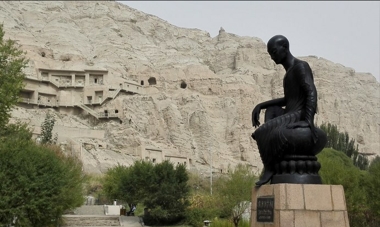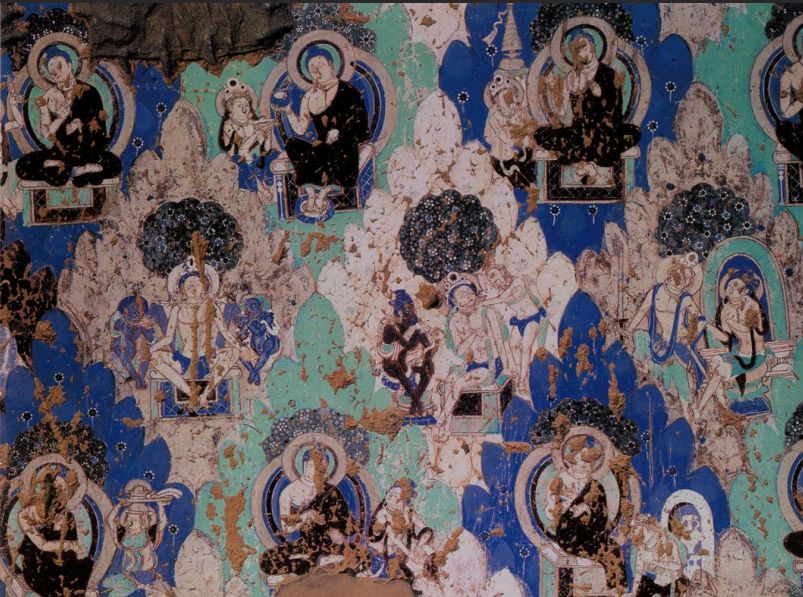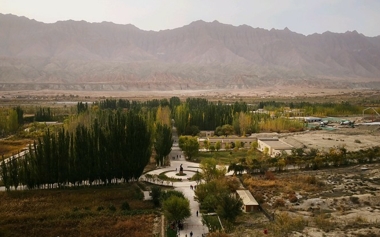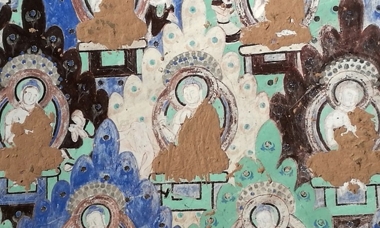Home > Attractions >
Kizil Thousand Buddha Caves
As one of well-known Grottoes on silk road tour destinations of China, Kizil Thousand Buddha Cave was built in the 3rd to 4th centuries or earlier; its peak period was in the 6th to 7th centuries, however the grottoes was gradually being abandoned after Tubo occupied Qiuci (an ancient state) at the end of the 8th century, and its successive construction lasted for five or six hundred years.
Introduction of Kizil Thousand Buddha Caves:
Kizil Thousand Buddha Caves is an earliest and largest grottoes in China. With the special grotto shape, mural theme and artistic style which profoundly reflect the situation of Qiuci Buddhism and represent the cultural and artistic level of the Qiuci nationality, and is an important place to visit and study the Buddhist culture and art.
What to visit in Kizil Thousand Buddha Caves:
Kizil Thousand Buddha Caves was excavated on the cliff of Qul-tagh Moutain by the Muzart River. The listed 236 caves can be divided into four parts: west of the valley, inner valley, east of the valley and back mountain, the shape of caves and the murals inside all have a vivid style of ancient Qiuci area. Among them, Chiti Grottoes is for Buddhist rites and Buddhist statues, the Pikholo Grottoes are the best places for monks to live in and sit in meditation.
Vihara Grottoes:
Vihara Grottoes, also known as monasteries, most of them are bedroom and corridor-type structures with simple living facilities such as kitchens and and other domestic installations. Most of these different types of grottoes are built together regularly. Meanwhile, according to its arrangement, each unit may be a Buddhist temple, and the structure and layout of these grottoes are rare in China's grotto buildings.
When is the best time to visit?
Aksu lies in the west of Xinjiang, on the western brim of Tarim Basin and the southern foot of the Tianshan Mountain, every May to October is the best time to travel in Aksu. Aksu is a temperate continental climate and it is also one of the regions with more solar radiations in China. It has abundant solar and thermal resources, large temperature difference between day and night, the annual average temperature is 9.9 to 11.5 Degree Celsius, and annual precipitation is 42.4 to 94.4 mm.
In summer, with intense light and ultraviolet radiation, even if you wear sunscreen, you'll get a tan. When you travel in winter, Aksu's snowscape will surprise you, however the dry and cold weather is not generally adaptable.
Other information of Kizil Thousand Buddha Caves:
The statues and murals in Kizil Thousand Buddha Cave are all painted in the Chaitya Cave. Although most of the statues have been destroyed, however, the murals are still well-preserved about 5,000 square metres. The subject of grottoes are mainly Buddhist biography, karma and native stories. In addition, the theme which reflected Maitreya and Buddhist subjects also has a certain proportion.
Traffic Information of Kizil Thousand Buddha Caves:
At present, there is no direct bus to the scenic area, so tourists have to drive or charter to Baicheng County.
Travel tips of Kizil Thousand Buddha Caves:
1.Tourists are not allowed to take pictures in grottoes. In addition, bags and cameras must be deposited.
2.Tourists are not allowed to touch murals and smoke in the grottoes, etc.
The admission ticket: 70 RMB/Person
Opening Time:
The scenic area is open all year round
Business hours of scenic spots: 10.00 AM to 8.00 PM
Introduction of Kizil Thousand Buddha Caves:
Kizil Thousand Buddha Caves is an earliest and largest grottoes in China. With the special grotto shape, mural theme and artistic style which profoundly reflect the situation of Qiuci Buddhism and represent the cultural and artistic level of the Qiuci nationality, and is an important place to visit and study the Buddhist culture and art.
What to visit in Kizil Thousand Buddha Caves:
Kizil Thousand Buddha Caves was excavated on the cliff of Qul-tagh Moutain by the Muzart River. The listed 236 caves can be divided into four parts: west of the valley, inner valley, east of the valley and back mountain, the shape of caves and the murals inside all have a vivid style of ancient Qiuci area. Among them, Chiti Grottoes is for Buddhist rites and Buddhist statues, the Pikholo Grottoes are the best places for monks to live in and sit in meditation.
Vihara Grottoes:
Vihara Grottoes, also known as monasteries, most of them are bedroom and corridor-type structures with simple living facilities such as kitchens and and other domestic installations. Most of these different types of grottoes are built together regularly. Meanwhile, according to its arrangement, each unit may be a Buddhist temple, and the structure and layout of these grottoes are rare in China's grotto buildings.
When is the best time to visit?
Aksu lies in the west of Xinjiang, on the western brim of Tarim Basin and the southern foot of the Tianshan Mountain, every May to October is the best time to travel in Aksu. Aksu is a temperate continental climate and it is also one of the regions with more solar radiations in China. It has abundant solar and thermal resources, large temperature difference between day and night, the annual average temperature is 9.9 to 11.5 Degree Celsius, and annual precipitation is 42.4 to 94.4 mm.
In summer, with intense light and ultraviolet radiation, even if you wear sunscreen, you'll get a tan. When you travel in winter, Aksu's snowscape will surprise you, however the dry and cold weather is not generally adaptable.
Other information of Kizil Thousand Buddha Caves:
The statues and murals in Kizil Thousand Buddha Cave are all painted in the Chaitya Cave. Although most of the statues have been destroyed, however, the murals are still well-preserved about 5,000 square metres. The subject of grottoes are mainly Buddhist biography, karma and native stories. In addition, the theme which reflected Maitreya and Buddhist subjects also has a certain proportion.
Traffic Information of Kizil Thousand Buddha Caves:
At present, there is no direct bus to the scenic area, so tourists have to drive or charter to Baicheng County.
Travel tips of Kizil Thousand Buddha Caves:
1.Tourists are not allowed to take pictures in grottoes. In addition, bags and cameras must be deposited.
2.Tourists are not allowed to touch murals and smoke in the grottoes, etc.
The admission ticket: 70 RMB/Person
Opening Time:
The scenic area is open all year round
Business hours of scenic spots: 10.00 AM to 8.00 PM







